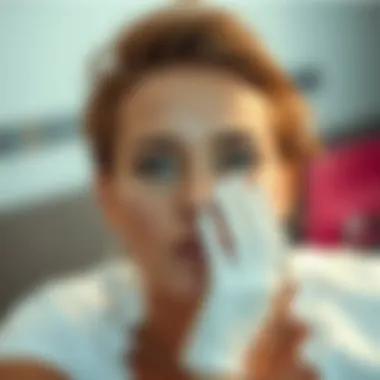Effective Strategies for Treating Severe Razor Burn


Intro
Razor burn can be a real skin nuisance, leaving many in distress after what should be a simple grooming ritual. Picture this: a morning routine turns into an uncomfortable ordeal filled with redness, itching, and irritation. For many, this suffering stems from improper shaving techniques or naturally sensitive skin. Understanding how to care for your skin post-shave is crucial.
This guide aims to address the key points concerning razor burn—examining its causes, exploring practical preventative measures, and aggregating a spectrum of treatment options. For readers, it offers insights drawn from holistic approaches, established over-the-counter remedies, and even professional interventions. It’s more than simply alleviating discomfort; it’s about understanding the art of maintaining healthy skin in this often-overlooked aspect of personal care.
Understanding Razor Burn
Understanding razor burn is essential for anyone who shaves, whether it’s a daily routine or an occasional event. This irritation is not merely a nuisance; it can hinder a person’s self-esteem and comfort. Knowledge about razor burn aids in recognizing its symptoms and encourages proactive measures. Fostering an awareness of razor burn's underlying causes and potential management strategies arms individuals with the tools needed to deal with this common skin complaint effectively.
Defining Razor Burn
Razor burn is a painful skin condition often characterized by redness, irritation, and a burning sensation that occurs after shaving. It's typically triggered by improper shaving techniques or using unsuitable products for certain skin types. Beyond just looking unsightly, the discomfort can be all-consuming at times. Understanding what razor burn is ultimately sets the foundation for effective treatment and prevention methods.
Common Symptoms
Common symptoms of razor burn can vary from mild to severe. Oftentimes, they manifest as:
- Redness: The skin area where shaving occurred often appears inflamed.
- Itching or Stinging: These sensations can be particularly bothersome.
- Bumps or Rash: Sometimes, small bumps develop, resembling acne or folliculitis.
- Dry patches or Flakiness: A decrease in moisture can lead to rough patches or peeling.
Recognizing these symptoms is crucial; they offer a clear indication when it’s time to rethink shaving habits or techniques.
Causes of Severe Razor Burn
Severe razor burn can stem from a variety of factors. It often arises from:
- Dull Blades: Using a worn-out blade creates excessive friction, leading to irritation.
- Improper Technique: Rushing through the process without preparation and not shaving in the hair growth direction increases the likelihood of razor burn.
- Sensitive Skin: Certain skin types are inherently more reactive to regular shaving, necessitating tailored care.
- Inadequate Moisturizing: Skipping pre-shave conditioners can leave skin defenseless, paving the way for irritation.
Understanding these causes helps build a more careful approach to shaving, ensuring the skin remains healthy and irritation-free.
Preventative Measures
Addressing and managing razor burn isn't just about remedies post-shaving—it's essential to take preventative measures to minimize the risk of flare-ups. These steps not only shield skin from undue irritation but also enhance your overall shaving experience.
Choosing the Right Razor
Taking the time to choose the appropriate razor is crucial. Men or women opting for a close shave mustn't just grab the first blade off the shelf, particularly if they have sensitive skin. There are different types of razors available: traditional safety razors, cartridge razors, and electric razors, each catering to distinct preferences and skin types. For those prone to razor burn, consider razors with fewer blades. While multi-blade razors promise a smoother shave, they can also produce more friction, leading to irritation.
Also, pay attention to the razor's maintenance. A dull blade can tug at the hair rather than slice through it cleanly, causing unnecessary stress to the skin. Therefore, change blades regularly—perhaps every five to seven shaves or even sooner if you notice any discomfort.
Shaving Techniques to Minimize Risk
It's not just the razor that contributes to razor burn; the technique matters. Here are some key strategies to keep in mind:
- Shave with the grain: This means following the natural direction of hair growth. Shaving against the grain can yield a closer shave but also increases irritation risks.
- Use light pressure: Apply only minimal pressure when the razor glides across the skin. Let the blade do the work rather than pressing it down hard.
- Keep the skin taut: This may prevent the shaver from snagging on loose skin, which can lead to nicks and subsequent irritation.
- Avoid rushing: Time is of the essence, but rushing through a shave can spell disaster. Take it slow and steady to ensure every stroke is deliberate and measured.
Natural Remedies for Razor Burn
Experiencing severe razor burn can leave one's skin feeling irritated, red, and sore. While over-the-counter solutions and professional treatments are valuable, it is essential to explore the comforting embrace of natural remedies. These methods often leverage the innate healing properties found in nature, offering gentle and effective alternatives to alleviate discomfort. With a focus on natural options, individuals can not only soothe existing irritation but also promote healthier skin in the long run.
Aloe Vera's Soothing Properties
Aloe vera is often touted as a miraculous remedy, and for good reason. The gel derived from its leaves possesses impressive anti-inflammatory and antibacterial properties, making it a favored choice for treating skin irritations, including razor burn. When applied, aloe vera forms a protective layer on the skin that can help reduce redness and promote healing.
You can use pure aloe vera gel directly from the plant or purchase a bottled version free from additives. Simply apply a small amount to the affected areas and allow it to sit for about 30 minutes before rinsing off with cool water. This process helps to calm and hydrate the skin, providing substantial relief without the sting or burn that some commercial products might cause.
"Natural remedies can serve as a gentle touch to healing, allowing the skin to recover without harsh chemicals."


Oatmeal Applications
Oatmeal is not only a hearty breakfast choice but also a beneficial ingredient for irritated skin. Colloidal oatmeal, a fine powder made from oats, has long been used as a remedy for various skin issues, including razor burn. It helps soothe irritation by forming a protective barrier on the skin and is packed with nutrients that can reduce inflammation and hydrate simultaneously.
To use oatmeal, mix a few tablespoons with warm water to create a paste. Apply this concoction directly to the inflamed areas and leave it on for about 20 minutes before rinsing. The cool sensation and soothing properties of oatmeal can work wonders for the skin, alleviating itchiness and discomfort associated with razor burn.
Coconut Oil Benefits
Coconut oil often pops up in wellness circles for its versatile benefits, and its role in skincare is particularly noteworthy. Thanks to its natural antibacterial and anti-inflammatory properties, coconut oil can be an excellent ally for those dealing with razor burn. It not only aids in hydration but also can prevent further skin damage during the healing process.
When applying coconut oil after shaving, make sure to use virgin or cold-pressed varieties, as these retain the most beneficial compounds. Simply massage a small amount into the affected areas and let it absorb. Coconut oil’s emollient properties help lock in moisture, ensuring that the skin can heal more effectively while remaining supple and nourished.
Natural remedies present a valuable toolkit for managing severe razor burn, providing an array of options that focus on gentle, effective healing. By integrating these remedies into their skincare regimen, individuals can foster healthier skin and experience less irritation over time.
Over-the-Counter Solutions
When tackling severe razor burn, over-the-counter solutions play a significant role in providing rapid relief and promoting skin recovery. These products are usually more accessible than prescriptions, making them a first-line defense. Using the right items can greatly reduce inflammation, soothe irritation, and aid in healing.
Topical Creams and Gels
Numerous topical creams and gels are available to alleviate razor burn symptoms. These formulations often contain ingredients aimed at reducing redness and promoting skin healing. Some notable components include aloe vera, witch hazel, and chamomile. These ingredients are known for their calming properties and are often found in products designed specifically for sensitive skin.
Applying a thin layer of these creams or gels right after shaving can make a world of difference. For example:
- Aloe Vera Gel: Renowned for its ability to hydrate and soothe skin, it can be effective in reducing discomfort associated with razor burn.
- Witch Hazel: Known for its astringent qualities, it can help tighten the skin and reduce inflammation.
It’s wise to always perform a patch test before trying any new product, especially if your skin is sensitive. That way, you can ensure that the cream or gel won’t aggravate your condition further.
Hydrocortisone for Inflammation
Hydrocortisone cream is another valuable option in the treatment of razor burn. This topical steroid works by reducing inflammation and itching. It is particularly effective when experiencing severe discomfort.
While using hydrocortisone:
- Follow the Instructions: Use it as directed, typically sparingly, on the affected areas. Applying too much can lead to undesirable side effects.
- Limit the Duration: It’s advisable to use hydrocortisone for a short time—generally not more than a week unless directed by a healthcare provider. Overuse can thin the skin or trigger other complications.
Hydrocortisone can provide significant relief, but it's essential to be mindful of its potency and to monitor how your skin reacts during use.
Antihistamines for Itching
Itching can often accompany razor burn, making the experience that much more annoying. Over-the-counter antihistamines can be useful in managing this aspect of razor burn. These medications work by blocking histamines, the compounds that trigger allergic responses, which often results in feelings of itchiness.
Considerations when using antihistamines:
- Types: Products like diphenhydramine (Benadryl) can be effective; however, some may cause drowsiness, so they are better taken at night.
- Non-Drowsy Options: For daytime use, look for non-drowsy formulas such as loratadine or cetirizine. These can help relieve discomfort without hindering your daily activities.
Overall, incorporating antihistamines into your razor burn treatment plan could greatly help improve your comfort as the healing process unfolds.
Remember: Always consult with a healthcare professional if your symptoms worsen or don't improve after trying over-the-counter remedies. Self-medicating can sometimes mask underlying issues in your skin that may need more comprehensive evaluation.
To explore more about razor burn and its management, you might find the following resources valuable:
Professional Treatments
Professional treatments for severe razor burn play a vital role when home remedies and over-the-counter solutions fall short. These treatments leverage advanced techniques often executed by trained specialists, helping individuals find significant relief from the painful redness and irritation associated with razor burn. Furthermore, they target the underlying skin issues that may exacerbate discomfort, ensuring a more comprehensive approach to skin health and well-being.
Dermatological Interventions


Dermatological interventions encompass a wide range of services tailored to address skin issues, including severe razor burn. When you visit a dermatologist, they begin with a thorough examination of your skin type and specific concerns. Depending on the assessment, treatments could include corticosteroid injections, which can decrease inflammation effectively.
In certain cases, dermatologists might prescribe topical medications designed to accelerate healing while reducing the chance of future irritation.
- Corticosteroid Creams: These are helpful for alleviating inflammation and soothing pain.
- Antibiotics: If there is a risk of infection due to broken skin, your dermatologist might suggest an antibiotic ointment.
To further aid healing, dermatologists often emphasize personalized skincare regimens, aligning with the unique needs of each patient. These tailored plans ensure that the products used at home complement professional treatments effectively, providing ongoing support for your skin's recovery.
Laser Treatments
Laser treatments have gained traction as an effective strategy for managing severe razor burn and related skin conditions. This method utilizes focused light energy to target and minimize skin irritations, allowing it to heal properly without long-term harm.
The precision of laser treatments encourages the regeneration of skin cells while soothing the upper layers, thereby reducing redness and discomfort. Various types of lasers can be used, depending on the severity of your particular case:
- Ablative Lasers: These lasers remove the outer layer of skin, promoting new skin growth.
- Non-Ablative Lasers: These target deeper skin layers without damaging the surface, focusing on collagen production and healing.
Despite the effectiveness, it is crucial to discuss potential side effects and required aftercare with a medical professional. These could include temporary redness, swelling, or even discomfort in the initial weeks following treatment. An informed discussion can significantly ease any apprehensions about this approach.
Chemical Peels
Chemical peels serve as another professional treatment for razor burn. This method involves using a chemical solution to exfoliate the damaged outer layer of skin, revealing a smoother, rejuvenated appearance beneath. There are varying depths of chemical peels, each tailored to specific skin sensitivities:
- Light Peels: Ideal for mild issues, these peels utilize gentle acids to treat superficial skin layers. They can help improve texture and even skin tone.
- Medium and Deep Peels: These are more intensive and target deeper skin issues, providing more dramatic results. However, they also require more downtime for recovery.
Chemical peels can vastly improve skin condition, especially in cases of chronic sensitivity post-shaving. However, the person undergoing such treatments must adhere to aftercare guidelines to secure optimal results and avoid complications. For instance, post-treatment sun protection becomes paramount to shield the newly exposed layers from harmful UV rays.
Ultimately, consulting with a dermatologist about laser treatments and chemical peels can unveil a pathway to healing that may be particularly beneficial for those struggling with persistent razor burn.
In summary, professional treatments can offer a multitude of options to effectively combat severe razor burn, bridging the gap that over-the-counter solutions may not fill. By consulting with professionals about dermatological interventions, laser treatments, and chemical peels, patients can secure tailored approaches that specifically cater to their skin's unique sensitivities.
Daily Skin Care Routine
A well-considered daily skin care routine can significantly impact the healing process of severe razor burn. This routine serves as a foundation for maintaining skin health and prevents future irritations. Here are some specific elements to focus on within your daily regimen that can bring relief and improve skin resilience.
Gentle Cleansing
At the core of effective skin care is the practice of gentle cleansing. Rushing through this step can worsen the condition of irritated skin. Opt for a mild cleanser, one free from harsh chemicals or strong fragrances, as these can further inflame sensitive areas. Look for products labeled as hypoallergenic or designed for sensitive skin.
When washing the affected area, use lukewarm water instead of hot, as excessive heat can aggravate razor burn. Apply the cleanser using your fingertips, avoiding any scrubbing motions. Rinse thoroughly, ensuring no suds remain, which could lead to additional irritation. By incorporating a gentle cleansing routine, the skin can begin to recover without unnecessary trauma.
Moisturizing After Shaving
Moisturizing should be a non-negotiable step after shaving, especially for those susceptible to razor burn. A quality moisturizer acts as a barrier, helping to lock in hydration and soothe the uncomfortable sensations often encountered post-shave. Ideally, choose a product that is designed specifically for post-shaving care, containing calming ingredients like chamomile or calendula.
Apply the moisturizer liberally but gently; think of it as providing a drink to thirsty skin. It can significantly reduce tightness and promote a nourished appearance. Incorporating this step into your daily routine, both after shaving and at other points, ensures the skin remains hydrated, which is essential for healing and preventing future flare-ups.
Exfoliation Practices
Exfoliation can be a bit of a double-edged sword when it comes to razor burn. While it’s designed to remove dead skin cells and promote cell turnover, harsh exfoliating practices can worsen irritation. Therefore, it is important to choose the right method and frequency based on your skin's specific needs.
For sensitive or affected skin, opt for a mild exfoliant, perhaps one with fine grains or a gentle exfoliating pad soaked in soothing ingredients. Limit exfoliation to once or twice a week to avoid overdoing it. This approach will help prevent buildup around hair follicles, which can lead to ingrown hairs and further complications.
To reap the benefits of exfoliation while respecting your skin's limits, always follow up with a rich moisturizer. This will replace moisture lost during the exfoliating process, leaving the skin soft and rejuvenated.
The key to effective long-term care lies in consistency and patience. A routine may take some time before showing results, but sticking with it pays off.


Integrating these daily skin care practices not only aids in healing current razor burn but also fortifies your skin against future issues. Keeping irritation at bay while nurturing your skin can cultivate a sense of comfort and confidence that transcends merely looking good.
Long-Term Care Strategies
Long-term care strategies are crucial in managing and minimizing the risk of severe razor burn and its recurring nature. By employing specific care techniques and understanding one’s skin, individuals can substantially reduce irritation and promote healthier skin over time. This section lays down effective methods, aimed particularly at women of all ages, to make skin more resilient against shaving trauma.
Identifying Skin Sensitivities
Understanding your skin type and identifying sensitivities can make all the difference when tackling razor burn. Every individual has a unique skin profile, which can sway dramatically based on factors such as age, hormonal changes, and even diet. Take the time to observe how your skin reacts after shaving. Look out for redness, swelling, or persistent itchiness. Documenting these reactions and seeking dermatologist advice can aid in pinpointing whether you have sensitive skin or any allergies to specific products.
- For example, many people don’t realize that frequently used ingredients like fragrances or alcohol can trigger adverse reactions. A simple patch test can help you gauge how your skin responds to new products.
“A stitch in time saves nine” — key to managing razor burn is catching sensitivities early.
Additionally, consider environmental factors such as temperature and humidity. If you notice that your skin flares up during specific seasons, adjusting your skincare routine accordingly can also mitigate overall sensitivity.
Adjusting Shaving Frequency
Another vital strategy for managing razor burn is to examine and, if needed, adjust your shaving frequency. This doesn’t mean that one size fits all, as different skin types require various approaches. For some, shaving every few days may work well, while others might find it less irritating to only shave weekly.
To determine the best frequency for your skin:
- Start by noting how your skin reacts when you shave. Are you consistently getting razor burn shortly after?
- Experiment with longer intervals between shaves to see if symptoms improve.
- Pay attention to how your skin feels and looks. It’s not just about avoiding razor burn; healthier skin is smoother and more resilient.
One strategy could be to alternate between shaving and other hair removal methods like waxing or using depilatory creams, which might give your skin the break it needs to recuperate.
Choosing Suitable Products
The importance of selecting the right products cannot be overstated when it comes to treating and preventing razor burn. Start with your shaving cream or gel; opt for those formulated specifically for sensitive skin. These products generally lack harsh chemicals or fragrances that can aggravate your skin further.
Consider the following when choosing your shaving essentials:
- Go for hypoallergenic products that are free from irritants.
- Look at ingredient lists and avoid alcohol-based products which can dry out and irritate skin.
- Be mindful of the blades in your razor. Investing in quality, multi-blade razors can yield smoother shaves with less tugging and pulling on your skin.
Finally, don’t overlook aftercare products. Select soothing balms or moisturizers rich in ingredients like chamomile or calendula. Regularly applying these not only fosters healing but also helps in regaining skin’s natural moisture balance after shaving.
With these strategies in mind, you’ll be on your way to healthier skin that handles shaving with grace, ensuring that your grooming routine is as comfortable as it can be.
Closure
In this final segment, we tie together the various threads woven throughout the article. Addressing razor burn isn't just a matter of immediate relief; it embodies a broader understanding of skin care that spans from prevention to long-term management. The knowledge shared here aids in demystifying razor burn, shifting perceptions from viewing it purely as an occasional nuisance to recognizing it as a condition that deserves attention and tailored strategies.
Recap of Essential Treatments
One of the core insights from this article is the importance of a multi-faceted approach when treating severe razor burn. Here’s a brief recap:
- Natural Remedies: Plant-based solutions, such as aloe vera, oatmeal, and coconut oil, offer soothing effects that can significantly mitigate irritation. These remedies are not only accessible but also provide gentle care without harsh chemicals.
- Over-the-Counter Solutions: Products like topical creams, hydrocortisone, and antihistamines can be effective in addressing inflammation and itching, allowing skin to recover more comfortably.
- Professional Treatments: In cases where at-home remedies fall short, seeking dermatological interventions or cosmetic procedures can provide substantial relief and improved skin appearance.
Additionally, maintaining a consistent skin care routine enhances the efficacy of these treatments, ensuring the skin's barrier remains strong. A gentle cleansing and frequent moisturizing regimen, coupled with proper exfoliation, help prevent the recurrence of irritation.
Encouragement for Individualized Approaches
It’s essential to emphasize the value of personalizing treatments based on individual skin types and sensitivities. Not every remedy or solution will suit everyone, thus encouraging experimentation within safe limits is key. For example, those with sensitive skin may find certain natural oils irritating while others thrive with them. Always listen to your body, and don’t hesitate to adjust your shaving technique or daily routine based on what your skin responds to best.
Empowering yourself with knowledge and an adaptable approach will enable the creation of a skin care regimen that not only alleviates текущий discomfort from razor burn but also promotes overall skin health.
With the insights and practical advice presented, you are now better equipped to tackle severe razor burn effectively. Remember, consistency is the cornerstone of successful skin care, and patience plays a vital role in achieving long-term results.
For further reading, consider exploring resources from established health websites such as Mayo Clinic, American Academy of Dermatology, or even gathering community insights from platforms like Reddit to enhance understanding and gather more personalized advice.







